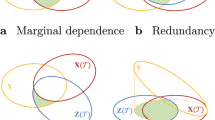Abstract
A novel method for online tracking of the changes in the nonlinearity within both real-domain and complex–valued signals is introduced. This is achieved by a collaborative adaptive signal processing approach based on a hybrid filter. By tracking the dynamics of the adaptive mixing parameter within the employed hybrid filtering architecture, we show that it is possible to quantify the degree of nonlinearity within both real- and complex-valued data. Implementations for tracking nonlinearity in general and then more specifically sparsity are illustrated on both benchmark and real world data. It is also shown that by combining the information obtained from hybrid filters of different natures it is possible to use this method to gain a more complete understanding of the nature of the nonlinearity within a signal. This also paves the way for building multidimensional feature spaces and their application in data/information fusion.













Similar content being viewed by others
References
Arenas-Garcia, J., Figueiras-Vidal, A., & Sayed, A. (2005). Steady state performance of convex combinations of adaptive filters. In Proceedings IEEE international conference on acoustics, speech and signal processing (ICASSP ’05) (Vol. 4, pp. 33–36).
Arenas-Garcia, J., Figueiras-Vidal, A., & Sayed, A. (2006). Mean-square performance of a convex combination of two adaptive filters. IEEE Transactions on Signal Processing, 54(3), 1078–1090.
Chen, M., Rutkowski, T., Jelfs, B., Souretis, G., Cao, J., & Mandic, D. (2007). Assessment of nonlinearity in brain electrical activity: A DVV approach. In Proceedings RISP international workshop on nonlinear circuits and signal processing.
Cichocki, A., & Unbehauen, R. (1993). Neural networks for optimisation and signal processing. New York: Wiley.
Gautama, T., Mandic, D., & Van Hulle, M. (2004). The delay vector variance method for detecting determinism and nonlinearity in time series. Physica D, 190(3–4), 167–176.
Jelfs, B., & Mandic, D. (2008). Signal modality characterisation using collaborative adaptive filters. In Proceedings IAPR workshop on cognitive information processing.
Jelfs, B., Vayanos, P., Chen, M., Goh, S., Boukis, C., Gautama, T., et al. (2006). An online method for detecting nonlinearity within a signal. In Knowledge-based intelligent information and engineering systems (pp. 1216–1223).
Kozat, S., & Singer, A. (2000). Multi-stage adaptive signal processing algorithms. In Proceedings of the IEEE sensor array and multichannel signal processing workshop (pp. 380–384).
Mandic, D. (2000). NNGD algorithm for neural adaptive filters. Electronics Letters, 36(9), 845–846.
Mandic, D., Chen, M., Gautama, T., Van Hulle, M., & Constantinides, A. (2008). On the characterisation of the deterministic/stochastic and linear/nonlinear nature of time series. Proceedings of the Royal Society A, 464(2093), 1141–1160.
Mandic, D., & Goh, S. (2008). Complex valued nonlinear adaptive filters: A neural network approach. New York: Wiley.
Mandic, D., Golz, M., Kuh, A., Obradovic, D., & Tanaka, T. (Eds.) (2007). Signal processing techniques for knowledge extraction and information fusion. New York: Springer.
Mandic, D., Vayanos, P., Boukis, C., Jelfs, B., Goh, S., Gautama, T., et al. (2007). Collaborative adaptive learning using hybrid filters. In ICASSP 2007 (Vol. 3, pp. 921–924).
Mandic, D., Vayanos, P., Javidi, S., Jelfs, B., & Aihara, K. (2008). Online tracking of the degree of nonlinearity within complex signals. In ICASSP 2008 (pp. 2061–2064).
Martin, R., Sethares, W., Williamson, R., & Johnson, C., Jr. (2002). Exploiting sparsity in adaptive filters. IEEE Transactions on Signal Processing, 50(8), 1883–1894.
Mizuta, H., Jibu, M., & Yana, K. (2000). Adaptive estimation of the degree of system nonlinearity. In Proceedings IEEE adaptive systems for signal processing and control symposium (AS-SPCC) (pp. 352–356).
Narendra, K., & Parthasarathy, K. (1990). Identification and control of dynamical systems using neural networks. IEEE Transactions on Neural Networks, 1(1), 4–27.
Schreiber, T. (1999). Interdisciplinary application of nonlinear time series methods. Physics Reports, 308(1), 1–64.
Schreiber, T., & Schmitz, A. (1997). Discrimination power of measures for nonlinearity in a time series. Physical Review E, 55(5), 5443–5447.
Vayanos, P., Chen, M., Jelfs, B., & Mandic, D. (2007). Exploiting nonlinearity in adaptive signal processing. In Proceedings ISCA workshop on non linear speech processing. New York: Springer.
Vayanos, P., Goh, S., & Mandic, D. (2006). Online detection of the nature of complex-valued signals. In Proceedings of the 16th IEEE signal processing society workshop on machine learning for signal processing (pp. 173–178).
Widrow, B., McCool, J., & Ball, M. (1975). The complex LMS algorithm. Proceedings of the IEEE, 63(4), 719–720.
Widrow, B., & Stearns, S. (1985). Adaptive signal processing. Englewood Cliffs: Prentice-Hall.
Acknowledgements
We would like to thank Prof. Kazuyuki Aihara, Institute of Industrial Science, University of Tokyo, Japan for providing the wind data.
Author information
Authors and Affiliations
Corresponding author
Rights and permissions
About this article
Cite this article
Jelfs, B., Javidi, S., Vayanos, P. et al. Characterisation of Signal Modality: Exploiting Signal Nonlinearity in Machine Learning and Signal Processing. J Sign Process Syst 61, 105–115 (2010). https://doi.org/10.1007/s11265-009-0358-z
Received:
Revised:
Accepted:
Published:
Issue Date:
DOI: https://doi.org/10.1007/s11265-009-0358-z




